Institution of Structural Engineers awards 2015 Gold Medal to Mike Schlaich
By Bustler Editors|
Wednesday, Apr 8, 2015

Related
The Institution of Structural Engineers announced Mike Schlaich, Managing Director of schlaich bergermann und partner and Professor of Structural Engineering at Technische Universität Berlin, as the recipient of the 2015 Gold Medal. As the Institution's highest prize since 1922, the Gold Medal recognizes an engineer's significant contributions to the field of structural engineering.
Throughout his career, Schlaich collaborated with the likes of Frank Gehry, the offices of Richard Rogers and Sir Nicholas Grimshaw, engineers like Ted Happold and Fazlur Khan, as well as artist Christo on the Mastaba project for the UAE. And the fact that Schlaich's father, Jörg Schlaich, also won the award 25 years ago adds an extra hint of sentimentality this year.
"A specialist in lightweight structures, Mike is a firm believer in a holistic, conceptual design approach, and in engineers’ responsibility to contribute more to 'baukultur' - that is the concept of producing quality structures to improve quality of life. He also has an enduring interest in creating free, clean, renewable energy by developing solar thermal power plants in the North African desert.
Examples of his remarkable designs can be seen around the world, from the Christian Garden in Berlin, to the Ting Kau cable-stayed bridge in Hong Kong and presently the new Yamuna cable-stayed bridge in New Delhi, India. All the projects reflect his belief that engineering should always strive to be elegant.
Mike said: 'Receiving the Gold Medal is a wonderful honor. When I think of the award’s previous winners, many of them my heroes, it makes me blush.'"
Check out some projects that Schlaich worked in:
Christlicher Garten
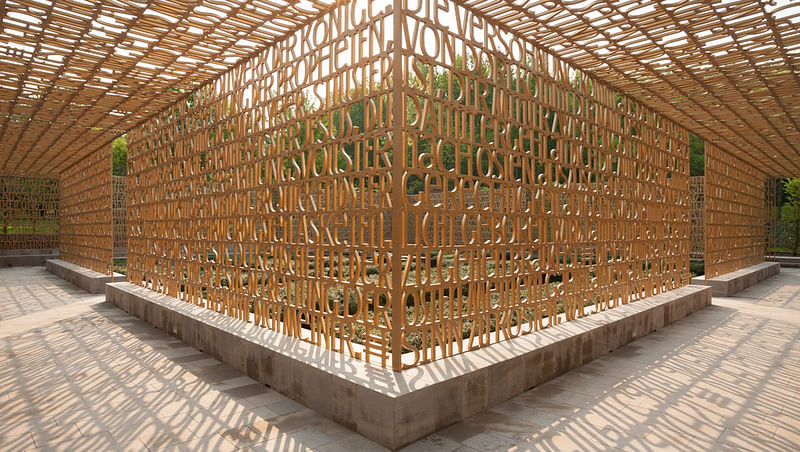
"The 'Christlicher Garten' ('Christian Garden') belongs to the 'Gardens of the World' within the wellness park Berlin-Marzahn. Its shape symbolizes a cloister's walkway imposed on a quadratic plan layout, surrounded by an orthogonal colonnade. For the design of the pergola the landscape archi- tects were looking for a minimal load bearing structure that would integrate the letters of Christian quotes on the walls and ceilings. The result was a spatial frame structure made of aluminum castings, in which the envelope and letters create the load bearing unit. The individual casting segments are connected through welds, screws, and bolts."
Weinberg Bridge - National Garden Exhibition 2015 Havel Region
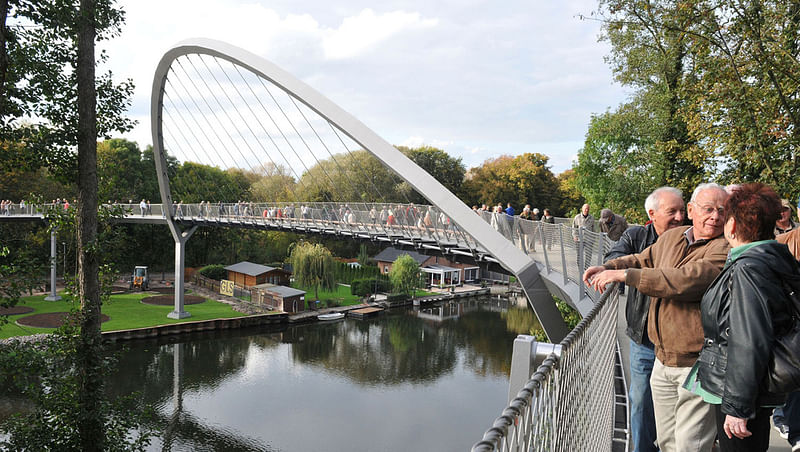
"The new pedestrian bridge crosses the Havel river in an S-curve from the Weinberg-Park to the Optikpark. Angled steel arches support the superstructure at the longest span length located over the river and secondary channel. The hangers are not located as usual along the outer edge of the circular edge beam, but rather on radial cantilevers that almost reach the arch planes. Thus the resultant of the hangers is angled only slightly away from the angled arch plane, leading to reduced bending stresses within the arch. The arches terminate at the height of the superstructure and thereby allow for the horizontal thrust to be short circuited via a tieback. Within the range of the arches, the bridge deck widens to allow for seating space. At the abutment the bridge deck is monolithically connected to the sub-structure, creating an integral structure."
Sassnitz Footridge
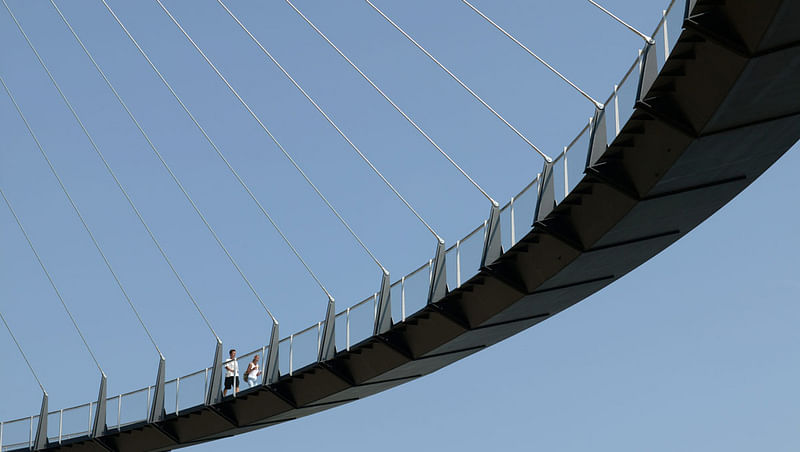
"The connection between the city center of Sassnitz and the harbor was to be achieved as a barrier free connection regardless of the large eleva- tion differential of 22 m. The special feature of the structure is clear in the one-sided suspension of the circular ring girder combined with the eccen- tric arrangement of hanger cables. The hanger cables are not attached, as is typical, along the superstructure, but instead connect to small cantilevers that run along the side of the walkway. This effectively connects the cable centerlines with the center of gravity of the super- structure. Through the reduced loading the superstructure could be designed to be extremely thin. Attached to the suspension bridge is an elevated composite structure ramped bridge. Cables with galfan coating ensure minimal maintenance even with the wet sea climate. The result is a light structure that presents an open view of the ocean and the harbor."
New Wear Bridge
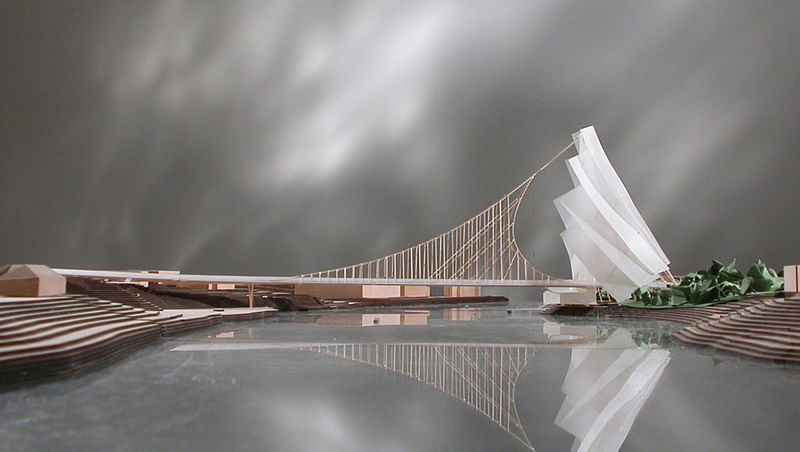
"The Concept Design for the New Wear Crossing is a state-of-the-art struc- ture which tries to combine lightness and elegance with economy and robustness. It is a cable-supported bridge which in this form has not been built before but which consists of commonly used and well approved components. An unsymmetric suspension bridge with a looped main cable crosses the river with a main span of almost 300 m. A slender composite deck of about 21 m width is supported by two planes of hanger cables. Their loads are carried by two sets of main cables which are connected to the single pylon of 100 m height which is located at the southern bank of the river."
Ting Kau Bridge
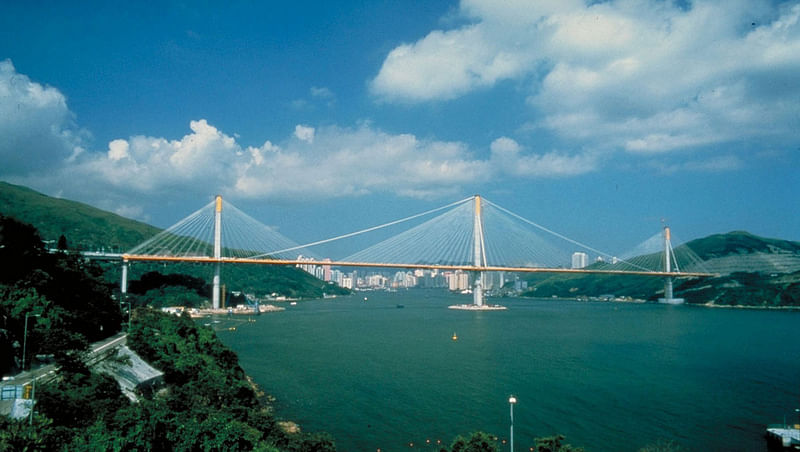
"The Ting Kau Bridge along with its approach bridges links the western New Territories as well as the mainland with the expressway Lantau Fixed Crossing, which connects the new Airport with Kowloon and Hong Kong. As one of the few realized multi-span cable-stayed bridges, the Ting Kau Bridge, with 1177 m of cable-supported deck, was at the time of its construction one of the worlds longest cable stayed bridges. A remark- able feature of this bridge structure are the two divided superstructures (composite superstructures consisting of a light-weight steel girder gril- lage and a pre-fabricated concrete deck slab), each 17.7 m wide. Single pylons are stabilized in the transverse direction by cables like masts of a sailboat; stabilization of the pylons between the two primary span widths via longitudinal cables between the pylon head and the crossing point of the superstructure with the neighboring pylons."
Canopy for exit of customer center of Autostadt in Wolfsburg
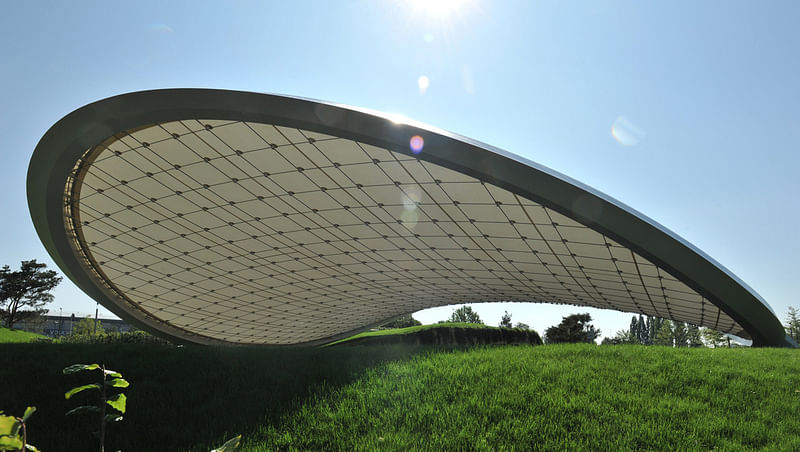
"The test track provides a space for drivers to try out the electronic systems of new car models. The design for the roof is based on the idea of a leaf in the landscape. It is composed of a saddle surface with only two minimalist support points on the ground, which integrates itself lightly and harmoniously into its surroundings. The support structure has an elliptical footprint and spans a length of 55 m and a width of 38 m. The global saddle geometry creates two peaks and two valleys, with the highest points approximately 6 m and 9 m higher than the lowest points. The saddle surface consists of a cable net supported PTFE-membrane, with a dynamically shaped hollow section edge beam made of doubly curved structural steel profiles along its perimeter. The membrane and cable net planes are both held in tension by the compression ring edge beam and are interconnected at the nodes of the cable net. "
Yamuna Bridge at Wazirabad
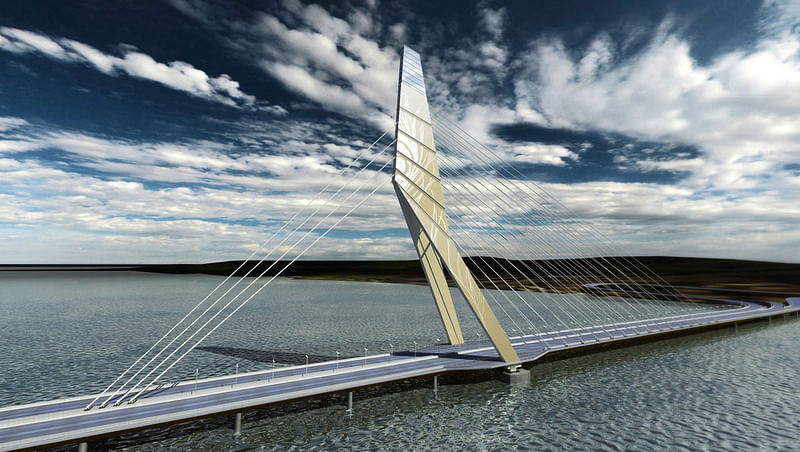
"The 'Signature Bridge' as the new landmark of New Delhi connects the city Wazirabad across the river Yamuna to the inner city. The boomerang shaped pylon consists of 2 inclined columns, which are rigidly connected to the driving lanes and bend mid-way. The upper portion of the pylon anchors the back-stay cables as well as the main-span cables, arranged in a harp like manner. The tip of the pylon is created by a 98 ft (30 m) high steel-glass structure, which can be illuminated to create a landmark visible from afar at night. A special detail of the bridge is that the self- weight of the pylon balances out the self-weight of the super structure through the eccentric location of its center of gravity with respect to the pivot point of the pylon footing. This serves well to reduce the load on the back-stay cables. The fact that the modules were bolted together on site instead of welded is an adjustment to the local method of construction."
Photos courtesy of the Institution of Structural Engineers.

Share
0 Comments
Comment as :